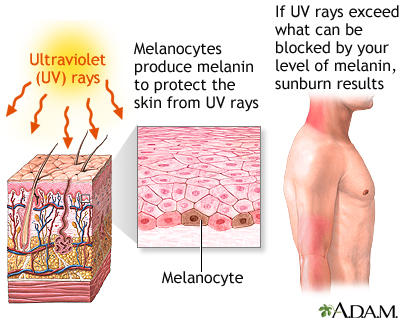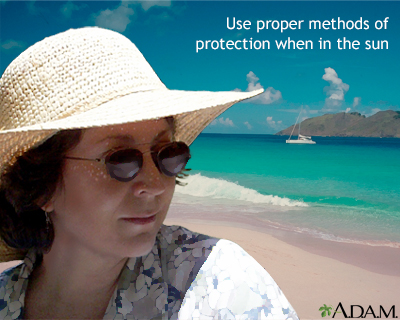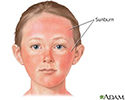Sunburn
Solar erythema; Burn from the sunA sunburn is reddening of the skin that occurs after you are overexposed to the sun or other ultraviolet light.
Considerations
The first signs of a sunburn may not appear for a few hours. The full effect to your skin may not appear for 24 hours or longer. Possible symptoms include:
- Red, tender skin that is warm to the touch
- Blisters that develop hours to days later
Blisters
A vesicle is a small fluid-filled blister on the skin.
 ImageRead Article Now Book Mark Article
ImageRead Article Now Book Mark Article - Severe reactions (sometimes called sun poisoning), including fever, chills, nausea, or rash
- Skin peeling on sunburned areas several days after the sunburn
Symptoms of sunburn are usually temporary. But the damage to skin cells is often permanent, which can have serious long-term effects. These include skin cancer and early aging of the skin. By the time the skin starts to become painful and red, the damage has been done. Pain is worst between 6 to 48 hours after sun exposure.
Skin cancer
Basal cell cancer is the most common form of cancer in the United States. Most skin cancers are basal cell cancer. Other common types of skin cancer...

Early aging of the skin
Aging changes in the skin are a group of common conditions and developments that occur as people grow older.

Causes
Sunburn results when the amount of exposure to the sun or other ultraviolet light source exceeds the ability of melanin to protect the skin. Melanin is the skin's protective coloring (pigment). Sunburn in a very light-skinned person may occur in less than 15 minutes of midday sun exposure, while a dark-skinned person may tolerate the same exposure for hours.
Melanin
Melanin is a natural substance that gives color (pigment) to: HairSkinThe iris of the eye It is produced by cells in the skin called melanocytes. Mel...

Keep in mind:
- There is no such thing as a "healthy tan." Unprotected sun exposure causes early aging of the skin and skin cancer.
- Sun exposure can cause first- and second-degree burns.
Burns
Burns commonly occur by direct or indirect contact with heat, electric current, radiation, or chemical agents. Burns can lead to cell death, which c...
 ImageRead Article Now Book Mark Article
ImageRead Article Now Book Mark Article - Skin cancer usually appears in adulthood. But it is caused by sun exposure and sunburns that began as early as childhood.
Factors that make sunburn more likely:
- Infants and children are very sensitive to the burning effects of the sun.
- People with fair skin are more likely to get sunburn. But even dark and black skin can burn and should be protected.
- The sun's rays are strongest during the hours of 10 a.m. to 4 p.m. The sun's rays are also stronger at higher altitudes and lower latitudes (closer to the equator). Reflections off water, sand, or snow can make the sun's burning rays stronger.
- Sun lamps can cause severe sunburn.
- Some medicines (such as the antibiotics doxycycline and tetracycline) can make your skin easier to sunburn.
- Some medical conditions (such as lupus) can make you more sensitive to the sun.
Lupus
Systemic lupus erythematosus (SLE) is an autoimmune disease. In this disease, the immune system of the body mistakenly attacks healthy tissue. It c...
 ImageRead Article Now Book Mark Article
ImageRead Article Now Book Mark Article
Home Care
If you do get a sunburn:
- Take a cool shower or bath or place clean wet, cool wash cloths on the burn.
- DO NOT use products that contain benzocaine or lidocaine. These can cause allergies in some people and make the burn worse.
- If there are blisters, dry bandages may help prevent infection.
- If your skin is not blistering, moisturizing cream may be applied to relieve discomfort. DO NOT use butter, petroleum jelly (Vaseline), or other oil-based products. These can block pores so that heat and sweat cannot escape, which can lead to infection. DO NOT pick at or peel away the top part of the blisters.
- Creams with vitamins C and E may help limit damage to skin cells.
- Over-the-counter medicines, such as ibuprofen or acetaminophen, help to relieve pain from sunburn. DO NOT give aspirin to children.
- Cortisone creams may help reduce inflammation.
- Loose cotton clothing should be worn.
- Drink lots of water.
Ways to prevent sunburn include:
- Use a broad-spectrum sunscreen of SPF 30 or higher. A broad-spectrum sunscreen protects from both UVB and UVA rays.
- Apply a generous amount of sunscreen to fully cover exposed skin. Reapply sunscreen every 2 hours or as often as the label says.
- Reapply sunscreen after swimming or sweating and even when it is cloudy.
- Use a lip balm with sunscreen.
- Wear a hat with a wide brim and other protective clothing. Light-colored clothing reflects the sun most effectively.
- Stay out of the sun during hours when the sun's rays are strongest between 10 a.m. and 4 p.m.
- Wear sunglasses with UV protection.
When to Contact a Medical Professional
Call your health care provider right away if you have a fever with sunburn. Also call if there are signs of shock, heat exhaustion, dehydration, or other serious reactions. These signs include:
- Feeling faint or dizzy
Faint
Fainting is a brief loss of consciousness due to a drop in blood flow to the brain. The episode most often lasts less than a couple of minutes and y...
Read Article Now Book Mark ArticleDizzy
Dizziness is a term that is often used to describe 2 different symptoms: lightheadedness and vertigo. Lightheadedness is a feeling that you might fai...
 ImageRead Article Now Book Mark Article
ImageRead Article Now Book Mark Article - Rapid pulse or rapid breathing
Rapid pulse
A bounding pulse is a strong throbbing felt over one of the arteries in the body. It is due to a forceful heartbeat.
 ImageRead Article Now Book Mark Article
ImageRead Article Now Book Mark ArticleRapid breathing
Hyperventilation is rapid and deep breathing. It is also called overbreathing, and it may leave you feeling breathless.
 ImageRead Article Now Book Mark Article
ImageRead Article Now Book Mark Article - Extreme thirst, no urine output, or sunken eyes
- Pale, clammy, or cool skin
- Nausea, fever, chills, or rash
Nausea
Nausea is feeling an urge to vomit. It is often called "being sick to your stomach. "Vomiting or throwing-up forces the contents of the stomach up t...
 ImageRead Article Now Book Mark Article
ImageRead Article Now Book Mark ArticleFever
Fever is the temporary increase in the body's temperature in response to a disease or illness. A child has a fever when the temperature is at or abov...
 ImageRead Article Now Book Mark Article
ImageRead Article Now Book Mark ArticleChills
Chills refers to feeling cold after being in a cold environment. The word can also refer to an episode of shivering along with paleness and feeling ...
 ImageRead Article Now Book Mark Article
ImageRead Article Now Book Mark ArticleRash
Rashes involve changes in the color, feeling or texture of your skin.
 ImageRead Article Now Book Mark Article
ImageRead Article Now Book Mark Article - Your eyes hurt and are sensitive to light
- Severe, painful blisters
What to Expect at Your Office Visit
Your provider will perform a physical exam and look at your skin. You may be asked about your medical history and current symptoms, including:
- When did the sunburn occur?
- How often do you get sunburn?
- Do you have blisters?
- How much of the body was sunburned?
- What medicines do you take?
- Do you use a sunblock or sunscreen? What type? How strong?
- What other symptoms do you have?
References
American Academy of Dermatology website. Sunscreen FAQs. www.aad.org/public/everyday-care/sun-protection/sunscreen-patients/sunscreen-faqs. Accessed June 20, 2023.
Dinulos JGH. Light-related diseases and disorders of pigmentation. In: Dinulos JGH, ed. Habif's Clinical Dermatology. 7th ed. Philadelphia, PA: Elsevier; 2021:chap 19.
Sherman KS. Sunburn. In: Kellerman RD, Rakel DP, Heidelbaugh JJ, Lee EM, eds. Conn's Current Therapy 2023. Philadelphia, PA: Elsevier; 2023:1125-1126.
Burns - illustration
The depth of a burn determines its severity. First degree burns damage the outer layer of skin (epidermis) and cause pain, redness and swelling (erythema). Second degree burns damage the epidermis and the inner layer, the dermis, causing erythema and blistering. Damage from third degree burns extend into the hypodermis, causing destruction of the full thickness of skin with its nerve supply (numbness). Third degree burns leave scars and may cause loss of function and/or sensation.
Burns
illustration
Sun protection - illustration
Clothing which blocks or screens the harmful rays of the sun (UVA and UVB), in combination with wide-brimmed hats, sunglasses, and sunscreen, are all helpful in preventing damage to the eyes and skin. Any one of these by itself, even the sunscreen, may not be enough to prevent sun damage.
Sun protection
illustration
Skin cancer, melanoma on the fingernail - illustration
Malignant melanoma is the most dangerous type of skin cancer. Melanomas beneath the fingernail appear as a black or bluish black discoloration. This type of malignancy spreads (metastasizes) readily.
Skin cancer, melanoma on the fingernail
illustration
Skin cancer, close-up of lentigo maligna melanoma - illustration
Increased risk for skin cancer, especially melanoma, is associated with chronic exposure to sunlight, blistering sunburns, and a family history of skin cancer.
Skin cancer, close-up of lentigo maligna melanoma
illustration
Skin cancer - close-up of level III melanoma - illustration
Malignant melanoma is the most dangerous type of the skin cancers. Typical features of melanomas include irregular borders, multiple colors within the lesion, rapid growth, and susceptibility to easy injury with bleeding. Any mole that exhibits any of these changes should be evaluated immediately by your physician.
Skin cancer - close-up of level III melanoma
illustration
Skin cancer - close-up of level IV melanoma - illustration
Malignant melanoma is the most dangerous type of the skin cancers. Typical features of melanomas include irregular borders, multiple colors within the lesion, rapid growth, and susceptibility to easy injury with bleeding. Any mole that exhibits any of these changes should be evaluated immediately by your physician.
Skin cancer - close-up of level IV melanoma
illustration
Skin cancer - melanoma superficial spreading - illustration
Malignant melanoma is the most dangerous type of the skin cancers. Typical features of melanomas include irregular borders, multiple colors within the lesion, rapid growth, and susceptibility to easy injury with bleeding. Any mole that exhibits any of these changes should be evaluated immediately by your health care provider.
Skin cancer - melanoma superficial spreading
illustration
Sunburn - illustration
Sunburn results when the amount of exposure to the sun or other ultraviolet light source exceeds the ability of the body's protective pigment, melanin, to protect the skin. A serious sunburn is as serious as a thermal burn, and may have the same systemic effects such as blistering, edema and fever.
Sunburn
illustration
Sunburn - illustration
When the skin is overexposed to the ultraviolet rays of the sun a sunburn can occur. The symptoms of a sunburn can take up to 24 hours to appear. The skin can be red, warm, tender, blistered, and swollen.
Sunburn
illustration
Burns - illustration
The depth of a burn determines its severity. First degree burns damage the outer layer of skin (epidermis) and cause pain, redness and swelling (erythema). Second degree burns damage the epidermis and the inner layer, the dermis, causing erythema and blistering. Damage from third degree burns extend into the hypodermis, causing destruction of the full thickness of skin with its nerve supply (numbness). Third degree burns leave scars and may cause loss of function and/or sensation.
Burns
illustration
Sun protection - illustration
Clothing which blocks or screens the harmful rays of the sun (UVA and UVB), in combination with wide-brimmed hats, sunglasses, and sunscreen, are all helpful in preventing damage to the eyes and skin. Any one of these by itself, even the sunscreen, may not be enough to prevent sun damage.
Sun protection
illustration
Skin cancer, melanoma on the fingernail - illustration
Malignant melanoma is the most dangerous type of skin cancer. Melanomas beneath the fingernail appear as a black or bluish black discoloration. This type of malignancy spreads (metastasizes) readily.
Skin cancer, melanoma on the fingernail
illustration
Skin cancer, close-up of lentigo maligna melanoma - illustration
Increased risk for skin cancer, especially melanoma, is associated with chronic exposure to sunlight, blistering sunburns, and a family history of skin cancer.
Skin cancer, close-up of lentigo maligna melanoma
illustration
Skin cancer - close-up of level III melanoma - illustration
Malignant melanoma is the most dangerous type of the skin cancers. Typical features of melanomas include irregular borders, multiple colors within the lesion, rapid growth, and susceptibility to easy injury with bleeding. Any mole that exhibits any of these changes should be evaluated immediately by your physician.
Skin cancer - close-up of level III melanoma
illustration
Skin cancer - close-up of level IV melanoma - illustration
Malignant melanoma is the most dangerous type of the skin cancers. Typical features of melanomas include irregular borders, multiple colors within the lesion, rapid growth, and susceptibility to easy injury with bleeding. Any mole that exhibits any of these changes should be evaluated immediately by your physician.
Skin cancer - close-up of level IV melanoma
illustration
Skin cancer - melanoma superficial spreading - illustration
Malignant melanoma is the most dangerous type of the skin cancers. Typical features of melanomas include irregular borders, multiple colors within the lesion, rapid growth, and susceptibility to easy injury with bleeding. Any mole that exhibits any of these changes should be evaluated immediately by your health care provider.
Skin cancer - melanoma superficial spreading
illustration
Sunburn - illustration
Sunburn results when the amount of exposure to the sun or other ultraviolet light source exceeds the ability of the body's protective pigment, melanin, to protect the skin. A serious sunburn is as serious as a thermal burn, and may have the same systemic effects such as blistering, edema and fever.
Sunburn
illustration
Sunburn - illustration
When the skin is overexposed to the ultraviolet rays of the sun a sunburn can occur. The symptoms of a sunburn can take up to 24 hours to appear. The skin can be red, warm, tender, blistered, and swollen.
Sunburn
illustration
Review Date: 6/7/2023
Reviewed By: Elika Hoss, MD, Assistant Professor of Dermatology, Mayo Clinic, Scottsdale, AZ. Also reviewed by David C. Dugdale, MD, Medical Director, Brenda Conaway, Editorial Director, and the A.D.A.M. Editorial team.












